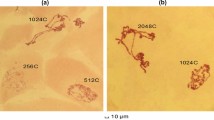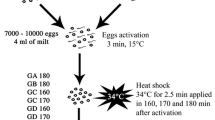Summary
-
1.
The small bristles on the surface of the wing ofDrosophila correspond each to a single cell. This fact makes possible the measurement of the size of the cells by counting the number of bristles within a known area of the wing surface.
-
2.
Comparison of the cell size in male, female, superfemale, supermale, intersex and triploid female showed that the size of the cells increases with the increase of the total volume of the chromosomes contained in their nuclei.
-
3.
The presence or absence of the Y-chromosome does not affect the size of the cells in spite of the considerable volume of the chromosome.
-
4.
The loss of one fourth chromosome reduces the size of the cells considerably in spite of the smallness of the volume of this chromosome.
-
5.
The mutant gene miniature alters the size of the cells strikingly. The epidermal cells of the wing membrane are apparent in miniature during the whole imaginal life of the fly; in wild-type and in all other mutants studied the epidermal cells degenerate soon after the emergence of the fly from the pupa.
-
6.
The size of the cells in different races of the same species is determined by the quality as well as by the quantity of the chromosomal material contained in their nuclei.
Zusammenfassung
-
1.
Jede der kleinen Borsten auf der Flügeloberfläche vonDrosophila korrespondiert mit einer einzigen Zelle. Dadurch ist die Mcssung der Zellengröße durch die Zählung der Borsten auf einem bestimmten Teil der Flügeloberfläche ermöglicht.
-
2.
Der Vergleich der Zellengröße bei den Männchen, Weibchen, Überweibchen, Übermännchen, Intersexen und den triploiden Weibchen zeigte, daß die Zellengröße wächst mit der Vermehrung der Gesamtmasse aller Chromosomen im Zellkern.
-
3.
Vorhandensein oder Fehlen des Y-Chromosoms ändert die Zellengröße nicht, trotz des beträchtlichen Umfanges dieses Chromosoms.
-
4.
Das Fehlen des sehr kleinen vierten Chromosoms setzt die Zellengröße beträchtlich herab.
-
5.
Das Gen „miniature“ verkleinert die Zellen sehr stark. Die Zellgrenzen in der Flügelepidermis von miniature sind stets sichtbar, während im Flügel der wilden Fliege und verschiedener anderen Mutanten die Epidermalzellen nach dem Schlüpfen der Fliege aus der Puppe schnell degenerieren.
-
6.
Die Zellengröße bei den verschiedenen Rassen derselben Art hängt von der Qualität und von der Quantität der Chromosomensubstanz in seinen Kernen ab.
Similar content being viewed by others
Literature cited
Artom, C. (1912): Le basi citologiche di una nuova sistematica del genereArtemia. Arch. Zellforschg9, 87–113.
Boveri, T. (1905): Zellen-Studien. 5. Über die Abhängigkeit der Kerngröße und Zellenzahl der Seeigellarven von der Chromosomenzahl der Ausgangszellen. 80 S.
Bridges, C. B. (1921): Triploid intersexes inDrosophila melanogaster. Science, N. S.54, 252–254.
— (1921): Genitical and cytological proof of non-disjunction of the fourth chromosome ofDrosophila melanogaster. Proc. natur. Acad. Sci. U. S. A.7, 127–132.
— (1925): Haploidy inDrosophila melanogaster. Ebenda11, 706–710.
Bridges, C. B. andAnderson, E. G. (1925): Crossing over in the X-chromosomes of triploid females ofDrosophila melanogaster. Genetics10, 418–441.
Dcmercc, M. (1926): Miniature — a second frequently mutating character inDrosophila virilis. Proc. natur. Acad. Sci. U. S. A.12, 183–193.
— (1928): The behavior of mutable genes. Verh. des V. internat. Kongr. Vererbungswiss.1, 183–193.
Gates, R. R. (1913): Tetraploid mutants and chromosomal mechanisms. Biol. Zbl.33, 113–150.
Gerassimow, J. J. (1902): Die Abhängigkeit der Größe der Zelle von Menge ihrer Kernmasse. Z. allg. Physiol.1, 220–258.
Hertwig, R. (1903):Über Korrela tion von Zell- und Kerngröße und ihre Bedeutung für die geschlechtliche Differenzierung und die Teilung der Zelle. Biol. Zbl.23, 49–62, 108–119.
Jorgensen, C. A. (1928): The experimental formation of heteroploid plants in the genusSolanum. J. of Gen.19, 133–211.
Morgan, T. II., Bridges, C. B. andSturtevant, A. H. (1925): The genetics ofDrosophila. Bibliographia Genetica2, 1–262.
v. Wettstein, F. (1924): Morphologie und Physiologie des Formwechsels der Moose auf genetischer Grundlage. 1. Z. indukt. Abstammgslehre33, 1–236.
v. Wettstein, F. (1928): Morphologie und Physiologie des Fromwechsels der Moose auf genetischer Grundlage. 2. Bibliotheca Genetica10, 1–216.
Winkler, H. (1916): Über die experimentelle Erzeugung von Pflanzen mit abweichenden Chromosomenzahlen. Z. Bot.8, 417–531.
Author information
Authors and Affiliations
Rights and permissions
About this article
Cite this article
Dobzhansky, T. The influence of the quantity and quality of chromosomal material on the size of the cells in drosophila melanogaster. W. Roux' Archiv f. Entwicklungsmechanik 115, 363–379 (1929). https://doi.org/10.1007/BF02078996
Received:
Issue Date:
DOI: https://doi.org/10.1007/BF02078996




